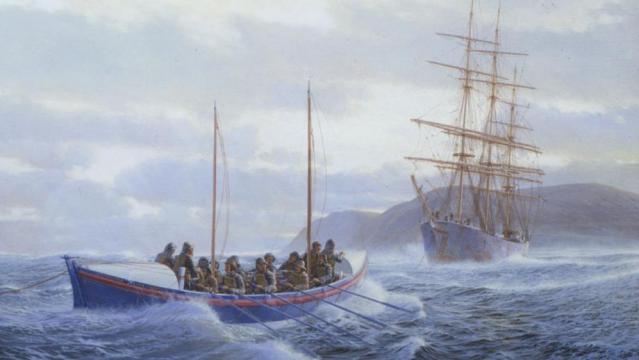By the time the Crew of the Louisa had completed their herculean task of dragging their vessel the thirteen miles up and down Countisbury Hill with a little help from their friends and eighteen horses, launched it, and rowed an hour out to the Forrest Hall, the stricken ship had managed to drop its anchors but was still drifting slowly close to Hurlstone Point. Some of the lifeboat crew boarded it to await the anticipated arrival of two tugs, while the rest kept the Louisa close by but at a safe distance, a feat that required them to keep rowing continuously.
Shortly after daybreak the two tugs arrived and, after successfully attaching a rope to the Forrest Hall, towed it across the Bristol Channel to Barry, with the Louisa following on in case the ship encountered any further difficulties. They arrived at Barry at 6pm that evening and after being fed and resting awhile at the Seamen’s Mission, the lifeboatmen set out once more to row across the Bristol Channel, reaching home at 11.30 am on January 14th.
With all crew members safe and the Forrest Hall repairable, its grateful owner, a Mr R H Fry from Liverpool, donated £75 towards the cost of silver watches and chains which were presented to the crew members of the Louisa, Jack Crocombe and the second Coxswain, George Richards, receiving gold watches and chains. Each crewman also received £5, but this astonishing feat of endurance and derring-do was not marked at the time by the award of the Royal National Lifeboat Institution’s (RNLI) “Victoria Cross” gold, silver, or bronze medals. The cost of making good the damage to property caused during the overland trek and flood damage to the Lynmouth lifeboat station came to £27 5s 6d.
Both the centennial and quasquicentennial anniversaries of one of the most remarkable feats in the RNLI’s history were celebrated with re-enactments of the overland trek, albeit in daylight and, for the treacherous stretches, using mechanical assistance in the form of tractors. Even the weather played its part, being almost as foul for the centenary celebrations as it had been a hundred years earlier.
Curiously, this was not the end of the ill fortune that dogged the Forrest Hall. On February 27, 1909, on a journey from Newcastle in Australia to Antofagasta in Chile with a cargo of 3,127 tons of coal, she ran aground on the coastline of Ninety Mile Beach on the far northern tip of the North Island of New Zealand, the only known case of a ship going ashore in calm seas and in clear daylight conditions, a subsequent inquiry recorded. All the crew were rescued and its wreckage can still be seen at low tide. There were suggestions that the captain, John Fenn Collins, had been experiencing epileptic fits on the voyage and had recklessly ignored the advice of his crew.
The RNLI has a proud record of fulfilling its mission to save lives at sea over two centuries. Long may it continue.
This post first appeared on Windowthroughtime | A Wry View Of Life For The World-weary, please read the originial post: here

